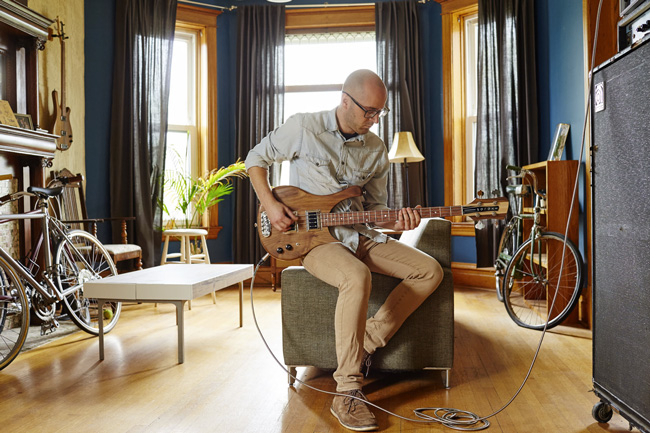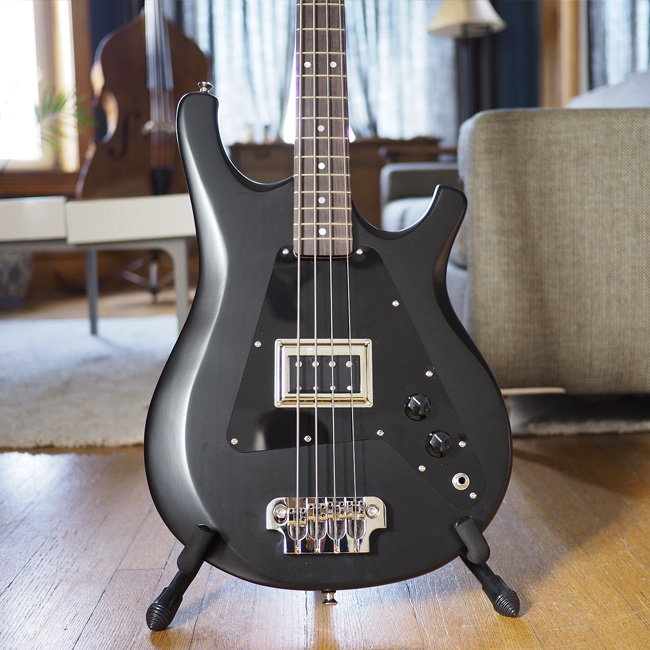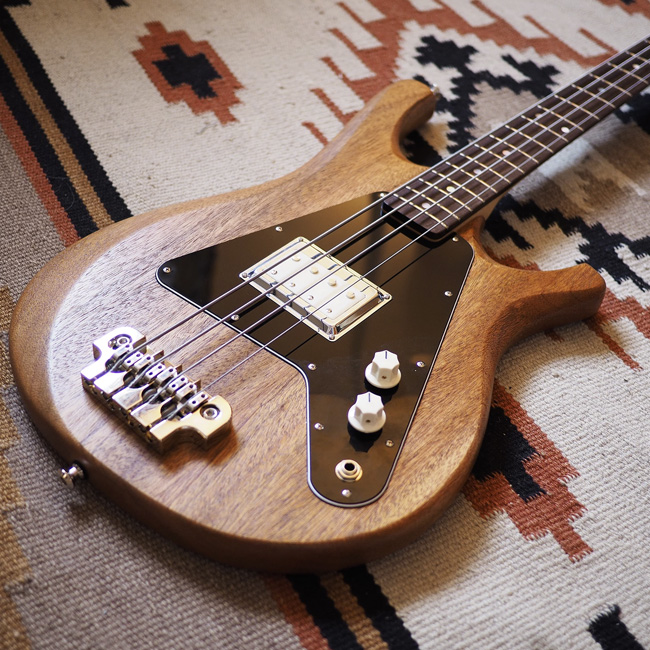Introduced to professional lutherie with an apprenticeship at Lakland Basses, it took a few years of being a touring bassist and part-time carpenter before Jake Serek joined his skill-sets together with Serek Basses. Though he built his company’s first Sacramento model bass at a boss’s cabinetry woodshop, it wouldn’t be long before he was working for himself full-time.
Since 2016, Serek has been creating vintage-inspired instruments that play with a modern feel—like a gigging uncle’s old standby but without the wiring issues. Now offering five models—most of which are named after streets in Chicago’s Logan Square neighborhood, where the company is based—Jake has found success hand-building basses from classic wood, high-quality pickups, and Hipshot hardware.
Before Jake presented with Reverb at this year’s Winter NAMM show, he sat down with us to talk about how he got his start and what he looks for when creating a new bass. Continue reading to learn more about what Serek Basses has to offer. You can pre-order and find completed basses from Serek Basses on Reverb today.
When did you start Serek Basses? And how you got into making instruments?

The company originally started in 2016. I had been building basses as a hobby for probably about five or six years before that. I guess I really got my start in about 2008/2009. I was finishing up college and looking for work. And while I was looking for a job, I got the bright idea to call up Dan Lakin over at Lakland Basses and just ask if I could bum around the shop.
I was always interested in the whole process—I was always tearing apart my instruments and things like that, so I figured if it was something I was good at, maybe I could find out that way. So I had a kind of apprenticeship or internship at Lakland for a couple years—just simple stuff, putting basses together, wiring up pickups, doing setups, and things like that. But the shop supervisor there also walked me through my first bass build from scratch. So that’s where I got hooked.
I had a few jobs in between—I did some general finish carpentry stuff, and worked at Third Coast guitar repair for a few years. So that kind of solidified my skill set.
And you were playing during that time too, right?
Yeah, playing during that time. I was actually out on tour for a couple years with a band called Bad City. We were pretty fortunate—our first tour was with the Smashing Pumpkins. And we toured with Slash and Kiss as well. So that lasted a good couple summers. And in between, I was coming back home and working a job installing kitchen cabinetry. My boss with that job had a woodshop. So on my off-time, I was kind of noodling around with different basses.
I actually built the first Sacramento at my boss’s cabinet shop. And then started building it up from there. In 2017, I went full-time with my own shop with Kevin Caton—he’s the same guy that was the supervisor at Lakland who taught me how to build basses.
He had quit Lakland and wanted to go full-time into acoustic building and called me up and said, "Hey, you still building basses? I’m thinking about starting a woodshop—any interest on going in on that with me?" So it was really interesting timing, because I was already thinking about that, and it worked out perfectly that we were able to this. [You can find Caton Guitars on Reverb too.]
Can you tell me about the different models that you make?
The first model I ever had is called the Sacramento. It’s sort of my tribute to like a Rickenbacker meets a Guild. There’s a lot of different variations of it. I make it in short-, medium-, and long-scale. I also make a solidbody version as well as a chambered-body version of it. So that’s the model that I have that has the most customization possibilities.
I also have the Midwestern and the Midwestern II, which are short-scale basses influenced by an old Epiphone design—the Epiphone Newport, back from like the early, early ‘60s, when they were still making them at Kalamazoo. So the Midwestern is kind of like a modernized version of that. And then the Midwestern II takes the modernization a step further, where it adds a lower cutaway for extra fret access, and the Midwestern II also has some two-pickup options.
Then there is the Armitage. I felt the need to have something that could go up against a Fender P-Bass. The first two—the Sacramento and Midwestern are both set-neck models. The Armitage is bolt-on, full-scale—my take on the P-Bass, is the best way to put it, but with its own unique look and different pickups.
The newest one is actually sort of a collaboration with the Bassment over at Chicago Music Exchange. Mark and I were talking, and we both love Gibson Grabbers and Rickenbackers, so I kind of smashed the two of those together. And it’s called the Lincoln—because CME’s on Lincoln. (There’s kind of a theme there.) It’s another bolt-on, full-scale bass, but the aesthetic is more reminiscent of the Gibson Grabber, and there’s gonna be a few different pickup options with that too.


What kinds of materials are you using? Favorite woods, hardware? Pickups?
For wood, I stick to pretty simple stuff. Once in a while, I’ll grab some exotic tops and make some fancier basses, as one-offs. But for my typical mode of production, I like to stick to walnut, maple, and mahogany mostly. They’re easily sourced wood, they’re sustainable, and they’re great to work with—good tonal properties and stability and all that good stuff. I also just like the utilitarian look. I do a lot of natural finishes. And mahogany and walnut especially just look great with a clear finish on it. Nothing too fancy or exotic. I’m not trying to up against, like, Alembic with crazy burl, sculpted, you know, stuff like that. But once in a while I do mess around with that stuff.
Hardware is pretty much exclusively Hipshot USA stuff. I do the ultra-light tuners, and there’s three different bridges of theirs I use, depending on the model. The tuners are great quality, the ultra-lights are awesome, because they’re so lightweight. I’m all about keeping my instruments super lightweight. That’s another thing with the wood—I handpick everything to try to be lightweight.
I kind of keep a limit—I try not to build anything over nine pounds. On average, my basses end up closer to the seven- to eight-pound range, even the full-scale ones. So, having the lightweight hardware is really helpful. And Hipshot’s just good quality. It’s trustworthy stuff. And they were willing to work with me early on, which was great.


Pickups, I’m a little bit more all over the place, just because I like to experiment with different sounds, and customers who are ordering always have other suggestions for me too. You’ll see that I use a lot of bi-sonic style pickups. I really, really like those. Sometimes they’re called darkstars. And I was introduced to those at Lakland.
Currently I’m using two different types of bisonic pickups. There’s a Guild reissue—Guild was the original producer of the bisonic pickup, and they have a reissue of it that’s really nice. I use that as a standard in a lot of models. And then there’s Curtis Novak, who makes some bisonics too that are really great. So I use those as kind of an upgrade, if people want to try something a little different.
And then toward the end of 2017, I started winding my own pickups in-house too. So right now I have two different styles of pickup. I have the B90, which is basically a P90 but wound specifically for bass.
It’s a single-coil pickup, just like a P90 is, but because it’s got a fatter and shallower bobbin, and it’s wound pretty heavily, it ends up being in P-Bass territory, but with a little more thickness and girth to it in the low-mid range, and maybe just a hair darker on top. Not quite as bright as a P-Bass, because I overwind them a little bit. And then I’m also going to be making the soapbar version for that too, if you don’t like the look of a dog-ear.
And then the other style of pickup, I’m calling them the Serek Singles. They’re another type of single-coil pickup. It’s a little confusing, because I’m actually making them in standard guitar-sized humbucker shells. So they fit in a standard humbucker route, like an EMG pickup would, but they’re single-coiled. I’m just working on different iterations of those right now.
They’re more similar to a Rickenbacker high-gain pickup. That’s kind of the sound I was going for. Again, they’re single-coils, but there’s a little bit more of an aggressive thing there—a little bit more mid-y and low-mid-y. Not quite as bright-scooped as a Jazz Bass pickup, but a little more mid-forward, I would say.
Is there anything else you want to add about what you think makes your basses unique to somebody that’s looking at other options?
The thing that’s been kind of made clear—because it’s hard to talk about on your own, but sometimes people give you good feedback. And I think a thing that’s been kind of pattern is, everybody seems to think that the basses have a really cool vintage vibe and a broken-in feel right out of the box.
I like the vintage aesthetic but I wanted to modernize the playability—the hardware, the pickups, you know, all that kind of stuff. Because a lot of vintage basses look really cool and they might feel OK, but the hardware is shit or the pickups suck or something like that. So I wanted to make a bass that is up to modern standards but feels like you’ve already had it sitting around for 30 years.





